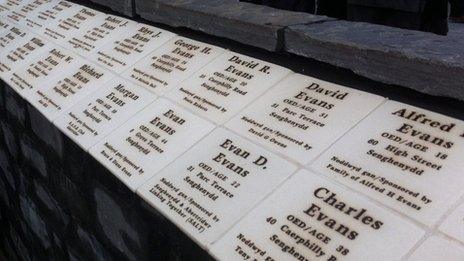Senghenydd: Centenary of UK's worst pit disaster marked
- Published
Relatives of the men and boys who died were among those who attended
A day of events marking the 100th anniversary of Britain's worst mining disaster is taking place in Senghenydd.
Hundreds have turned out in the streets of the Caerphilly county village where an explosion killed 439 miners and a rescuer at the Universal Colliery on 14 October, 1913.
A national memorial has been unveiled to mark the event and other mining tragedies in Wales.
Relatives of the men and boys who died were among those who attended.
William Vizzard fell unconscious but was rescued from the mine
A day of ceremony and commemoration is marking the explosion which happened just after 8am on 14 October, 1913.
It had been caused by a build up of firedamp (methane) gas being ignited.
The blast disturbed coal dust on the mine floor, raising clouds that then also caught alight, spreading the destruction further.
The fire was mainly confined to the west side of the mine, with the east side blocked with noxious gases. The result was over 400 men trapped underground.
It was not the first time tragedy had hit the village, a few miles along the Aber Valley from Caerphilly.
An explosion at the colliery in 1901 killed 81 men and there was criticism that the pit owners did not learn the lessons from it.
A report following that explosion recommended certain safety procedures should be followed. An extended deadline of September 1913 to implement the safety measure was missed by the mine bosses.
Just six weeks later, 439 miners and a rescuer died when another blast ripped through the colliery.
There had been 950 men down Universal's three pits that day.
Over the fortnight that followed those trapped were helped to safety with the last 18 men rescued more than two weeks later.
Funerals for those who died took place over the next month.
One hundred years later, the Wales National Mining Memorial was unveiled to remember the Senghenydd disaster and 150 other mining tragedies in Wales including the most recent, when four men died at Gleision in the Swansea Valley in 2011.
The memorial is a bronze statue of a rescue worker helping a miner.
The day of events in Senghenydd started with the sounding of the original Universal Colliery pit hooter at 08:10 BST, exactly as it did a century ago when it sounded to alert the village to what had happened in the pit.

The details of those killed in the two Senghenydd disasters were inscribed on tiles near the mining memorial
A walled garden was also opened with tiles inscribed with the details of those killed in the two Senghenydd disasters as well as a "path of memory," which marks the other colliery tragedies in Wales.
Patron Roy Noble paid tribute to "the men who paid the ultimate sacrifice in their quest for coal" and added it was a "tragic end to the stepping stones leading to disaster".
People lined streets in Senghenydd as the hooter was blown
A hooter marked the end of the service, which was attended by First Minister Carwyn Jones.
Mr Jones said it was "absolutely right" that there should be a national mining memorial to the "thousands of men and boys who died simply trying to earn a living".
The Aber Valley Heritage Group has been behind fundraising for the memorial.
Jack Humphreys, group chairman, said: "It has been a hundred years since the disaster at the Universal Colliery, but the impact that the explosion had on this small mining community is still felt today.
"We hope the event is a fitting tribute to the victims of the explosions in Senghenydd and mining disasters across Wales."
He told BBC Radio Wales: "It's very important for local people and people nationally. It's surprising the number of people who have come from far and wide to be with us this morning.
"There will be many people here today who have had family connections with those who were killed in the disasters of 1901 and 1913."
Hilary Barbrook, a local florist from Caerphilly, lost both her grandfathers at Senghenydd.
"We've spoken for years over the tragedy that has happened in this pit, but it's 100 years and it's nice that we're going to honour the people who died," she said.
"The village was grown around the pit because beforehand it was farm land and when they sunk the pit, they built the houses around it so everyone was involved.
"My grandmother had a lot of work, she had eight children and was eight months pregnant with the last one when my grandfather died.
"She used to take in washing, ironing, clean houses. She made all of her own clothes for the children so they didn't go without. She worked tremendously hard to keep the family together."
Wales' footballers were wearing black armbands in training to mark the disaster. They fly to Belgium later for their final World Cup qualifying game.
A BBC One Wales programme, Senghenydd - Britain's Worst Mining Disaster, will be shown on BBC One Wales at 22:45 BST on Monday 14 October.
Britain's worst ever mining disaster has been remembered a century after 439 miners and one rescuer lost their lives in an explosion at Senghenydd in South Wales.
- Published14 October 2013
- Published14 October 2013
- Published14 October 2013
- Published14 October 2013
- Published14 October 2013
- Published21 September 2013
- Published28 June 2012
- Published14 October 2010
- Published28 June 2012